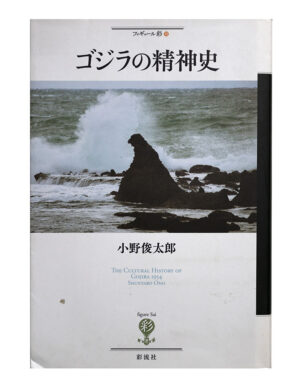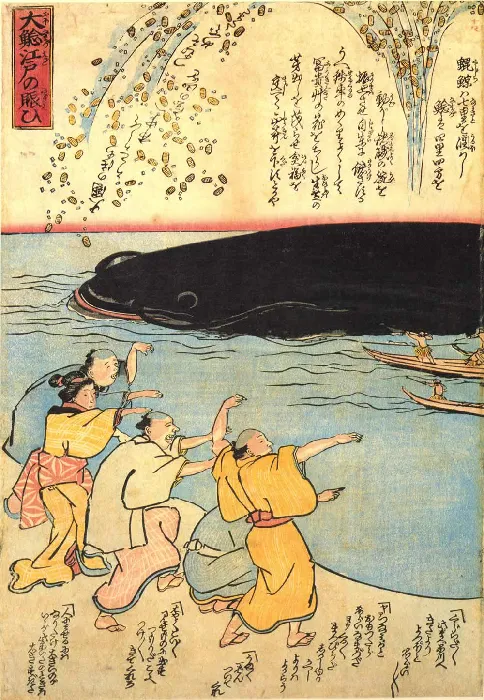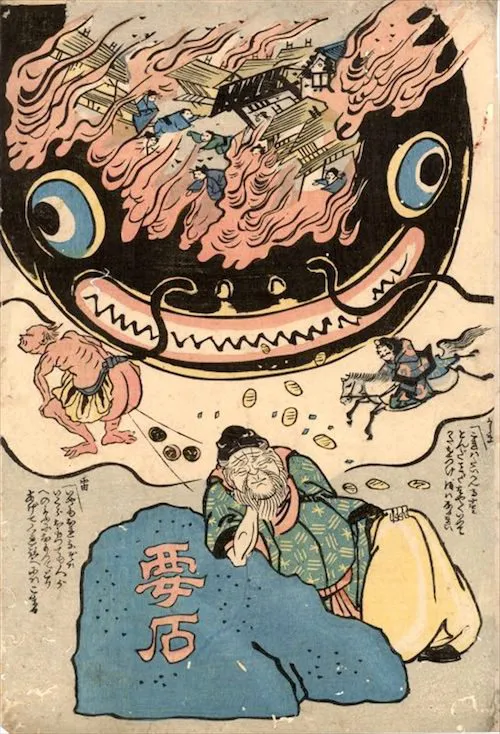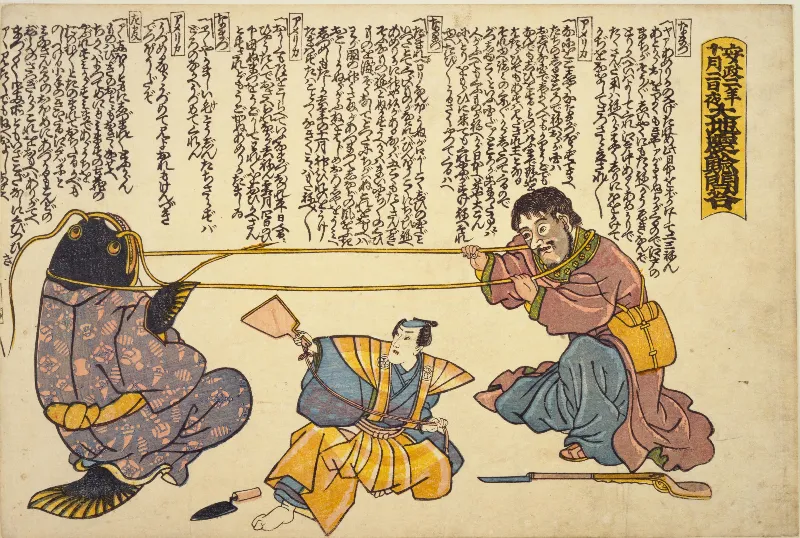7.7.2023
The Cultural History of Godzilla – Pt 53


P 142
もちろん地震の元凶であるナマズをこらしめる鯨絵も多い。新吉原で多くの女郎や客が死亡したので、総出でナマズを叩いている絵もある。遊郭が逃げ出せない構造になっていたのが死因だった。だが、安政の大地震で庶民だけでなく金持ちに大きな被害を与え、その後の建築の復興景気や救済のための富の分配をもたらすので、エビスとされた。醜い容貌なのに福をもたらす七福神のエビス神とクジラとナマズの三者はつながり、時には互換性さえもつとアウエハントは言う。
Of course, there are many whale paintings that punish the catfish, which is the cause of earthquakes. Many prostitutes and guests died in Shin-Yoshiwara, so there is also a picture of everyone beating catfish. The cause of death was that the red-light district had a structure that prevented escape. However, the Great Ansei Earthquake inflicted great damage not only on the common people but also on the wealthy, and it was called Ebisu because it brought about the restoration of the building industry and the distribution of wealth for relief. Ebisu, one of the seven gods of good fortune despite its ugly appearance, and whales and catfish are connected, and sometimes even compatible, according to Ouwehand.
Cornelis Ouwehand was a Dutch anthropologist and a scholar of Japanese folklore. He is considered the founder of Japanese Studies in Switzerland. (Source: Wikipedia)
浜辺に打ち寄せられた鯨はエビスさまと呼ばれもする。たとえば、三宅島では天保三年(一八三二)に鯨が浜に寄せられ、その肉が五か村の飢饉を救ったので供養をする鯨神社がある。これなどはまさにエビスだろう。追ってきた鰯を浜にもたらすのでエビスだという伝承が青森などにあった。それに、寛永の品川沖のクジラも九日間の見世物となり、人々は高い船賃を払ってまで押しかけてにぎわった。さらに将軍家斉が浜御殿(現在の浜離宮)で見物までし、最後は四十二両で払い下げられて、油を絞ってお金になったのだ。
A whale washed up on the beach is also called Ebisu-sama. For example, on Miyakejima, a whale was brought to the beach in 1832, and there is a whale shrine where a memorial service is held because the meat saved five villages from famine. This is exactly Ebisu. In Aomori and other places, there is a legend that Ebisu brings the sardines it chases to the beach. In addition, the whales off the coast of Shinagawa in the Kan’ei period were a nine-day spectacle, and people paid a high boat fare to flock to see them. In addition, Shogun Ienari went to Hama Palace (currently Hamarikyu) to see the sights, and in the end it was sold for 42 ryo [pre-Meiji unit of currency], and the oil was squeezed into money.
そして「大江戸の賑い」という絵では、明らかにナマズとクジラを同一視して、海に浮かんだ真っ黒なナマズが背中から潮を噴き上げていて、そこに小判や銭が舞っている。また、「切腹鯨」といって、罪滅ぼしに腹を切るとそこから小判がざくざくとあふれている絵がある。まさに当時の人にとってナマズは破壊者でありながら、同時に救済者なのだ。
And in the painting “Bustling of Oedo,” catfish and whales are clearly seen as the same thing, and the black catfish floating in the sea is blowing up the tide from its back, and gold coins and coins are dancing there. In addition, there is a painting called “Seppuku Kujira,” in which gold coins overflow from the belly of a person who cuts his stomach to atone for his sins. For the people of that time, the catfish was both a destroyer and a savior at the same time.

Bustling of Oedo (大鯰江戸の賑い) (Source: 江戸ガイド)
宮田登の指摘でもうひとつ重要なのは、こうしたナマズが「世直し」と結びついていることだ。絵には「世直し鯰」という画題のものがある。そこではナマズが金持ちの口や尻から金貨や銭を下にいる人々の前に吐き出させている。
Another important point pointed out by Noboru Miyata is that these catfish are related to “reformation of the world.” One of the paintings has the title of “Yonetsu no Catfish.” There, the catfish spits out coins and coins from the rich man’s mouth and buttocks in front of the people below.

「世直し鯰」 (Source: 江戸ガイド)

P 142
「世直し」といえば、お札が降ってきて「ええじゃないか」と踊る運動や、米などが高騰しておこった打ちこわしや一揆などと結びつき、幕末の世相を示す言葉として私たちは記憶している。「世直し大明神」が出現したり「日本国へは神が降る、唐人屋敷にゃ石が降る」という攘夷風の歌さえあったという(佐々木潤之助『世直し』)。だが、「世直し」というのは、もともと地震や雷のときの魔除けの言葉だった。
When we hear the word “world reform,” we remember it as a word that indicates the social conditions at the end of the Tokugawa shogunate, such as the movement of falling banknotes and dancing “Ee ja nai ka!” It is said that ‘Yonaoshi [World Reform] Daimyojin [Deity]’ appeared, and there was even a Joi-style song, ‘A god descends upon Japan, and stones descend upon Tojin Yashiki’ (Junnosuke SASAKI “Yonaoshi”). However, the word “yonao” [world reform] was originally a word used to ward off evil spirits during earthquakes and thunderstorms.
“Ee ja nai ka” were carnival-like religious celebrations (e.g. dancing festivals) that occurred across Japan from June 1867 to May 1868 (Source: Jisho.org)
近松門左衛門に『日本振袖始』(一七一八年)というスサノオを主人公にしてヤマタノオロチ退治の出雲神話を題材にした文楽の台本がある。その序段で、帝と結婚した美人の妹の木花開耶姫と容貌の違いを比べて女房たちが陰口を叩いているのを姉の岩長姫が聞いて、御殿も揺らぐ雷声で一喝する。かみなりそうすると女房たちが「世直し、世直し、桑原と生きたる心地はなかりけり」とある。桑原のほうも雷よけで、菅原道真が雷神となって都をおびやかしたときに、領地の桑原には雷が落ちなかったからだとされている。
Chikamatsu Monzaemon wrote a Bunraku script titled “Nihon Furisode Hajime” (1718), with Susanoo as the main character and the theme of the Izumo myth of exterminating Yamata no Orochi. At the beginning of the ceremony, Princess Iwanaga heard her sister gossiping about the difference in appearance between Princess Konohanasakuya, the beautiful younger sister of the emperor, and her sister, and the palace shook. Take a drink with your voice. When he was about to do so, the wives said, “The world will change, the world will change, and Kuwabara will not live comfortably.” Kuwabara also protects against lightning, and it is said that when Sugawara no Michizane became the god of thunder and threatened the capital, lightning did not strike Kuwabara in his territory.
Susanoo descended into the land of Izumo in western Japan and killed an eight-headed dragon that had been terrorizing the countryside. From the tail of the dragon he recovered the marvelous sword Kusanagi that he presented to his sister and that later came to form part of the Imperial Treasures of Japan.
岩長姫は嫉妬から帝の宝剣を盗むところをスサノオに倒されるのだが、蛇となって姿を消す。最後に登場するヤマタノオロチがじつはこの岩長姫の化身で、スサノオは恋仲となった稲田姫が食べられてしまったのを救いだし、奪われた宝剣をとりもどす。安珍清姫など大蛇に変貌する話ともつながるし、岩長姫=ヤマタノオロチに連なる怪異としてゴジラを考えると、雌だと推定したくもなってくる。ナマズとつながる「世直し」はそうした災厄やたたりを恐れたまじない言葉から、縁起直しに酒を飲んだりする意味となる。そもそも、東南海そして江戸というように太平洋岸に地震が頻発しアメリカやロシアの黒船が来たので、嘉永から安政へと元号を変えたのも、縁起をかついだ世直しの一種だった。
Out of jealousy, Iwanagahime stole the Emperor’s treasured sword and was defeated by Susanoo, but she turned into a snake and disappeared. Yamata no Orochi, who appears at the end, is actually the incarnation of Princess Iwanaga, and Susanoo rescues Princess Inada, who has fallen in love with her, from being eaten, and retrieves her stolen treasure sword. It’s also connected to the story of Anchin Kiyohime transforming into a giant snake, and when I think of Godzilla as a monster linked to Iwanagahime = Yamata no Orochi, I’m tempted to presume it’s a female. The word “yonaoshi” [world reform], which is connected to catfish, comes from a word that is not afraid of such disasters and harassment, and it means to drink sake to restore auspiciousness. In the first place, earthquakes frequently occurred along the Pacific coast, such as the Tonankai and Edo, and black ships from the United States and Russia came to Japan.

P 143
世直しは西欧の蜂起や革命のような積極的な意味ではなくて、厄払いがもとにある。それは、明治以降も「戦が向こうからやってくる」だとか「兵隊にとられる」といった自分たちの主体的な関与を認めない表現で述べてきた心情とも似ている。まさに触らぬ神にたたりなしなのだ。
Social reform is based on exorcism, not in a positive sense like uprisings and revolutions in Western Europe. This is similar to the sentiments that have been expressed since the Meiji era, using expressions such as “the war is coming from the other side” and “being taken by soldiers,” which do not acknowledge their independent involvement. It’s no match for God who doesn’t touch it.
「世直し」の意味が幕末にかけて積極的なものに変化する途中に安政の大地震があったとされる(北原糸子『地震の社会史』)。むしろ厄除けのまじないをはじめとする複数の意味が「世直し」という言葉に同居していると考えるべきだろう。安政の江戸ならぬ昭和の東京に来訪するゴジラは百年前の「世直し鯰」の延長なのだ。
It is said that the Great Ansei Earthquake occurred during the period when the meaning of ‘reformation of the world’ changed to something positive towards the end of the Edo period. Rather, it should be considered that multiple meanings, including a spell to ward off evil, coexist with the word “world reform.” Godzilla visiting Showa-era Tokyo, not Ansei-era Edo, is an extension of the 100-year-old “Reformed Catfish.”
日本は大地震や大火という災厄を、嘆き悲しむ悲劇としてだけでなく、むしろ新しく復興したり、弊害をなくす契機ととらえてきた。『ゴジラ』のなかで国会議事堂を破壊する場面が出てきたときに五四年当時の観客が喝采したのも、こうした「世直し」の心情につながるからだ。ゴジラの破壊によって、現実のこう着状態がシステムごとつぶされることで、「世直し」や「御一新」が到来すると思えて、気分がすっとするのだ。自分たちには出来ない変革を外圧であるが大地震を使ってやってくれる。そこから一種の解放感が生まれる。ゴジラが巨大なクジラあるいはその代理としてのナマズのように、世直しのために出現した怪異として受け止められても不思議ではない。
Japan has viewed disasters such as large earthquakes and fires not only as tragedies to mourn, but rather as opportunities for new reconstruction and the elimination of evil. The reason why the audience in 1954 applauded when the scene of destroying the National Diet building appeared in “Godzilla” is related to this sentiment of “restructuring the world.” By destroying Godzilla, the real stalemate will be crushed along with the system, and it will make me feel refreshed to think that “world reform” and “renewal” will come. Although it is external pressure, we will use a big earthquake to make changes that we cannot do. A kind of liberation comes from that. It is no wonder that Godzilla is perceived as a monster that has appeared to reform the world, like a giant whale or a catfish as its proxy.
じつは、二つの外圧の代表であるペリーとナマズが首引きの遊びをするという設定の「安政二年十月二日夜大地震鯰問答」という絵が残っている。どちらかがこけると負けになるゲームだが、「アメリカ」と「なまづ」が問答をしている。どうやらナマズは愛国心あふれる攘夷派のようで、ペリーの一行に立ち去れといっている。江戸庶民を敵から守るために地震を起こした、と言いたげである。
In fact, there is a picture called “Night of October 2nd, 1913, Great Earthquake Catfish Question and Answer,” in which Perry and Catfish, representatives of the two external pressures, play neck-pulling games. It’s a game where you lose if one of you loses, but “America” and “Namazu” are having a question and answer. Catfish seems to be a patriotic anti-foreigner and tells Perry to leave. He seems to say that he caused the earthquake to protect the common people of Edo from enemies.

“Night of October 2nd, 1913, Great Earthquake Catfish Question and Answer” 「安政二年十月二日夜大地震鯰問答」 (Source: Wikipedia.com)